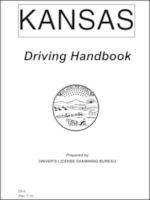 The Kansas Driver's License Examining Bureau maintains the Kansas Driving Handbook, (also known as the "Driver's License Handbook") as an educational tool "for those wishing to drive in Kansas". "Whether you are a teenager trying to get a license for the first time, or you are a seasoned driver renewing your license, virtually everything you need to know can be found in this handbook."
The Kansas Driver's License Examining Bureau maintains the Kansas Driving Handbook, (also known as the "Driver's License Handbook") as an educational tool "for those wishing to drive in Kansas". "Whether you are a teenager trying to get a license for the first time, or you are a seasoned driver renewing your license, virtually everything you need to know can be found in this handbook."
The handbook can be thought of as a more condensed and more readable version of the offical Kansas statutes. As such, it's an important resource, both for drivers and for other roadway users, such as bicyclists.
Here are a few excerpts from the handbook relate to how drivers should interact with bicyclists:
Drive In Proper Lane (Page 12)
Remember: A bicycle or motorcycle in a traffic lane is entitled to the full use of that lane. Do not drive in a manner that will deprive the cyclist of full use of his lane.
When Bicycles Are Present (Page 24)
As an operator of a bicycle, the cyclist is expected to obey all traffic laws and regulations on the streets, roads, and highways of the State. However, whether the bicyclist is operating lawfully or not, give the rider the benefit of the doubt. As a motorist you should realize that the bicyclist has the same rights and responsibilities as you. Mutual respect for one another will aid in smooth, traffic flow. The bicycle is a slow-moving and highly vulnerable vehicle, and almost any type of collision will result in injury or death to the rider. You should keep the following facts and safety tips firmly in mind:
- Be especially careful when passing a bicycle. Sometimes the cyclist is inexperienced; sometimes the rider may make an unexpected maneuver. Give a bicycle plenty of room, and be prepared for a quick stop.
- Remember that a bicycle is sometimes difficult to see amid other traffic. The hours of darkness, or when visibility conditions are poor, are especially dangerous. Be watchful of cyclists along the road or intersections, and adjust your movements to allow for any turns they may make.
- If the cyclist is traveling between you and the side of road as you are preparing to turn, be sure the cyclist knows of your intention, and is not in your path as you make the turn. If the rider is riding along the right edge of the roadway, in accordance with the law, your must wait until the cyclist slows down to allow you to turn in front of the cycle, or proceeds through the turning area before you make your turn.
To The Bicyclist
Keeping three important principles in mind will help the adult bicyclist to share the road safely with motor vehicles and pedestrians: control, predictability, and visibility.
Before you venture into traffic, make sure that you have mastered the control of your bicycle; riding in a straight line, and turning and stopping smoothly. Riding your bicycle in a predictable manner is essential to your safety on the road. This means riding with the traffic, not against it; signaling your intentions clearly and in plenty of time; and choosing a path of travel which won't result in you swerving into traffic to avoid hazards. Increasing your visibility will help to protect you on the road. Clothes of bright colors during the day, and white or yellow plastic is an excellent option; it will both protect you and make you more visible. At night, always have the required headlight and rear reflector on your bicycle; a red taillight and additional reflectors are also helpful.
Bicycles
Motorists in Kansas should expect to encounter bicyclists on all state and local roadways except for the Interstate system where bicyclists are prohibited or where prohibited by local ordinance. Please be considerate of bicyclists who have rights to the roadway. Expect bicyclists to be two feet from the right edge of the roadway or curb. When passing a bicyclist use extreme caution and pass four feet to the left of the bicyclist.
Notes:
- This is the 02-2013 edition of the handbook; the official version at ksrevenue.org may be newer.
- Where the Drivers Handbook and the Kansas Statutes are in conflict, the statutes are "the law" and the handbook is a "recommendation".
- The handbook may be slightly out of date compared with the statutes.
- At this time, the handbook recommends a four-foot passing distance, while the Kansas statutes (as amended in 2011) says "not less than three feet".



